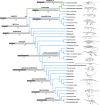Homeotic effects, somitogenesis and the evolution of vertebral numbers in recent and fossil amniotes
- PMID: 20080660
- PMCID: PMC2836685
- DOI: 10.1073/pnas.0912622107
Homeotic effects, somitogenesis and the evolution of vertebral numbers in recent and fossil amniotes
Abstract
The development of distinct regions in the amniote vertebral column results from somite formation and Hox gene expression, with the adult morphology displaying remarkable variation among lineages. Mammalian regionalization is reportedly very conservative or even constrained, but there has been no study investigating vertebral count variation across Amniota as a whole, undermining attempts to understand the phylogenetic, ecological, and developmental factors affecting vertebral column variation. Here, we show that the mammalian (synapsid) and reptilian lineages show early in their evolutionary histories clear divergences in axial developmental plasticity, in terms of both regionalization and meristic change, with basal synapsids sharing the conserved axial configuration of crown mammals, and basal reptiles demonstrating the plasticity of extant taxa. We conducted a comprehensive survey of presacral vertebral counts across 436 recent and extinct amniote taxa. Vertebral counts were mapped onto a generalized amniote phylogeny as well as individual ingroup trees, and ancestral states were reconstructed by using squared-change parsimony. We also calculated the relationship between presacral and cervical numbers to infer the relative influence of homeotic effects and meristic changes and found no correlation between somitogenesis and Hox-mediated regionalization. Although conservatism in presacral numbers characterized early synapsid lineages, in some cases reptiles and synapsids exhibit the same developmental innovations in response to similar selective pressures. Conversely, increases in body mass are not coupled with meristic or homeotic changes, but mostly occur in concert with postembryonic somatic growth. Our study highlights the importance of fossils in large-scale investigations of evolutionary developmental processes.
Conflict of interest statement
The authors declare no conflict of interest.
Figures


Similar articles
-
Fossils reveal the complex evolutionary history of the mammalian regionalized spine.Science. 2018 Sep 21;361(6408):1249-1252. doi: 10.1126/science.aar3126. Science. 2018. PMID: 30237356
-
Adaptive landscapes challenge the "lateral-to-sagittal" paradigm for mammalian vertebral evolution.Curr Biol. 2021 May 10;31(9):1883-1892.e7. doi: 10.1016/j.cub.2021.02.009. Epub 2021 Mar 2. Curr Biol. 2021. PMID: 33657406
-
A large-scale view of the evolution of amniote development: insights from somitogenesis in reptiles.Curr Opin Genet Dev. 2013 Aug;23(4):491-7. doi: 10.1016/j.gde.2013.02.011. Epub 2013 Mar 14. Curr Opin Genet Dev. 2013. PMID: 23499412 Review.
-
Developmental mechanisms of macroevolutionary change in the tetrapod axis: A case study of Sauropterygia.Evolution. 2017 May;71(5):1164-1177. doi: 10.1111/evo.13217. Epub 2017 Mar 21. Evolution. 2017. PMID: 28240769 Free PMC article.
-
Development and evolution of the tetrapod skull-neck boundary.Biol Rev Camb Philos Soc. 2020 Jun;95(3):573-591. doi: 10.1111/brv.12578. Epub 2020 Jan 7. Biol Rev Camb Philos Soc. 2020. PMID: 31912655 Free PMC article. Review.
Cited by
-
A large aberrant stem ichthyosauriform indicating early rise and demise of ichthyosauromorphs in the wake of the end-Permian extinction.Sci Rep. 2016 May 23;6:26232. doi: 10.1038/srep26232. Sci Rep. 2016. PMID: 27211319 Free PMC article.
-
The neck as a keystone structure in avian macroevolution and mosaicism.BMC Biol. 2023 Oct 13;21(1):216. doi: 10.1186/s12915-023-01715-x. BMC Biol. 2023. PMID: 37833771 Free PMC article.
-
The ecological origins of snakes as revealed by skull evolution.Nat Commun. 2018 Jan 25;9(1):376. doi: 10.1038/s41467-017-02788-3. Nat Commun. 2018. PMID: 29371624 Free PMC article.
-
A long-tailed marine reptile from China provides new insights into the Middle Triassic pachypleurosaur radiation.Sci Rep. 2022 May 5;12(1):7396. doi: 10.1038/s41598-022-11309-2. Sci Rep. 2022. PMID: 35513463 Free PMC article.
-
Ancestry of motor innervation to pectoral fin and forelimb.Nat Commun. 2010 Jul 27;1(4):49. doi: 10.1038/ncomms1045. Nat Commun. 2010. PMID: 20975699 Free PMC article.
References
-
- Richardson MK, Allen SP, Wright GM, Raynaud A, Hanken J. Somite number and vertebrate evolution. Development. 1998;125:151–160. - PubMed
-
- Carroll SB. Endless Forms Most Beautiful. New York: Norton; 2005.
-
- Gomez C, et al. Control of segment number in vertebrate embryos. Nature. 2008;454:335–339. - PubMed
-
- Dequéant ML, Pourquié O. Segmental patterning of the vertebrate embryonic axis. Nat Rev Genet. 2008;9:370–382. - PubMed
Publication types
MeSH terms
LinkOut - more resources
Full Text Sources

